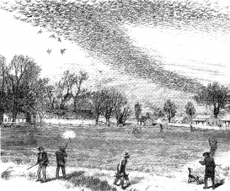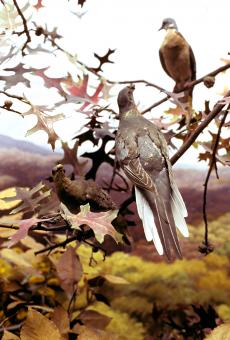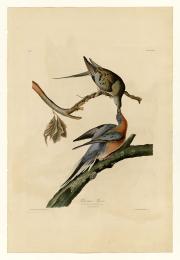 In the fall of 1914, a three hundred pound block of ice was shipped from the Cincinnati Zoo to the Smithsonian’s National Museum of Natural History. It held the remains of the last of a species that had once turned the skies of North America dark when its enormous flocks were in migration. The cold and lonely final migration was made by Martha, the last known passenger pigeon (Ectopistes migratorius), who had resided at the Cincinnati Zoo since 1902. Estimated to be twenty-nine years old, she was named in honor of George Washington’s wife, Martha.
In the fall of 1914, a three hundred pound block of ice was shipped from the Cincinnati Zoo to the Smithsonian’s National Museum of Natural History. It held the remains of the last of a species that had once turned the skies of North America dark when its enormous flocks were in migration. The cold and lonely final migration was made by Martha, the last known passenger pigeon (Ectopistes migratorius), who had resided at the Cincinnati Zoo since 1902. Estimated to be twenty-nine years old, she was named in honor of George Washington’s wife, Martha.

 Passenger pigeons were more brightly-colored than the related Mourning Dove (Zenaida macroura). They were also larger than other species of pigeons that we are used to seeing today, some 14-16 inches long, with long wings, and a long, pointed tail. They had particularly large breast muscles that enabled them to fly for long distances. The male passenger pigeon had an olive-gray back, rusty breast, slate-blue head, and iridescent neck. Female passenger pigeons were similar to males, but were somewhat duller and browner. It is estimated that the passenger pigeon was once the most numerous species of bird in North America, if not the world, and had lived there for over 100,000 years. Between three and five billion passenger pigeons once inhabited the deciduous forest region of the eastern United States and from southern Canada to Kansas, Oklahoma, Mississippi, and Georgia. During the breeding season, massive flocks gathered to mate in New England, the Mid-Atlantic region, the Ohio River valley, and the lower Great Lakes, but they wintered in the southeastern US. These social birds lived in enormous colonies, with up to 100 nests in a single tree. When flocks migrated overhead, their formations were a mile wide, went on for days, and turned the skies dark.
Passenger pigeons were more brightly-colored than the related Mourning Dove (Zenaida macroura). They were also larger than other species of pigeons that we are used to seeing today, some 14-16 inches long, with long wings, and a long, pointed tail. They had particularly large breast muscles that enabled them to fly for long distances. The male passenger pigeon had an olive-gray back, rusty breast, slate-blue head, and iridescent neck. Female passenger pigeons were similar to males, but were somewhat duller and browner. It is estimated that the passenger pigeon was once the most numerous species of bird in North America, if not the world, and had lived there for over 100,000 years. Between three and five billion passenger pigeons once inhabited the deciduous forest region of the eastern United States and from southern Canada to Kansas, Oklahoma, Mississippi, and Georgia. During the breeding season, massive flocks gathered to mate in New England, the Mid-Atlantic region, the Ohio River valley, and the lower Great Lakes, but they wintered in the southeastern US. These social birds lived in enormous colonies, with up to 100 nests in a single tree. When flocks migrated overhead, their formations were a mile wide, went on for days, and turned the skies dark.

 After Martha arrived at the US National Museum, she was studied by ornithologist Robert Shufeldt and her skin was prepared for display by taxidermists William Palmer and Nelson Wood. She was on display in the Natural History Building’s Bird Hall in the 1920s through the early 1950s, and in the Birds of the World exhibit that ran from 1956 until 1999. She also had four flights to break the monotony, winging her way first class, escorted by a flight attendant, to the San Diego Zoological Society’s Golden Jubilee Conservation Conference in 1966, and in June 1974 returning to the Cincinnati Zoological Gardens for the dedication of a new building named in her honor. She will return to public display on June 24, 2014, in the Smithsonian Institution Libraries exhibit Once There Were Billions: Vanished Birds of North America on the ground floor of the National Museum of Natural History. Be sure to stop by to see her!
After Martha arrived at the US National Museum, she was studied by ornithologist Robert Shufeldt and her skin was prepared for display by taxidermists William Palmer and Nelson Wood. She was on display in the Natural History Building’s Bird Hall in the 1920s through the early 1950s, and in the Birds of the World exhibit that ran from 1956 until 1999. She also had four flights to break the monotony, winging her way first class, escorted by a flight attendant, to the San Diego Zoological Society’s Golden Jubilee Conservation Conference in 1966, and in June 1974 returning to the Cincinnati Zoological Gardens for the dedication of a new building named in her honor. She will return to public display on June 24, 2014, in the Smithsonian Institution Libraries exhibit Once There Were Billions: Vanished Birds of North America on the ground floor of the National Museum of Natural History. Be sure to stop by to see her!
Related Resources
- Once There Were Billions: Vanished Birds of North America exhibition, Smithsonian Institution Libraries
- "Martha," The Last Passenger Pigeon, National Museum of Natural History Centennial website
- Passenger Pigeons, Encylopedia of Life
- Project Passenger Pigeon
Produced by the Smithsonian Institution Archives. For copyright questions, please see the Terms of Use.

Leave a Comment